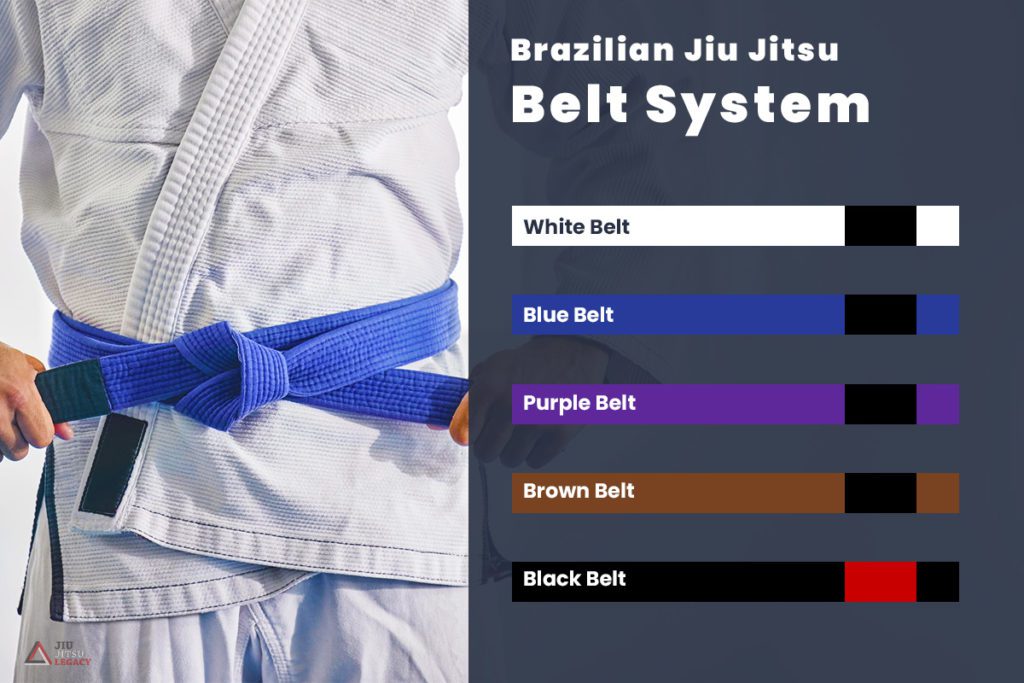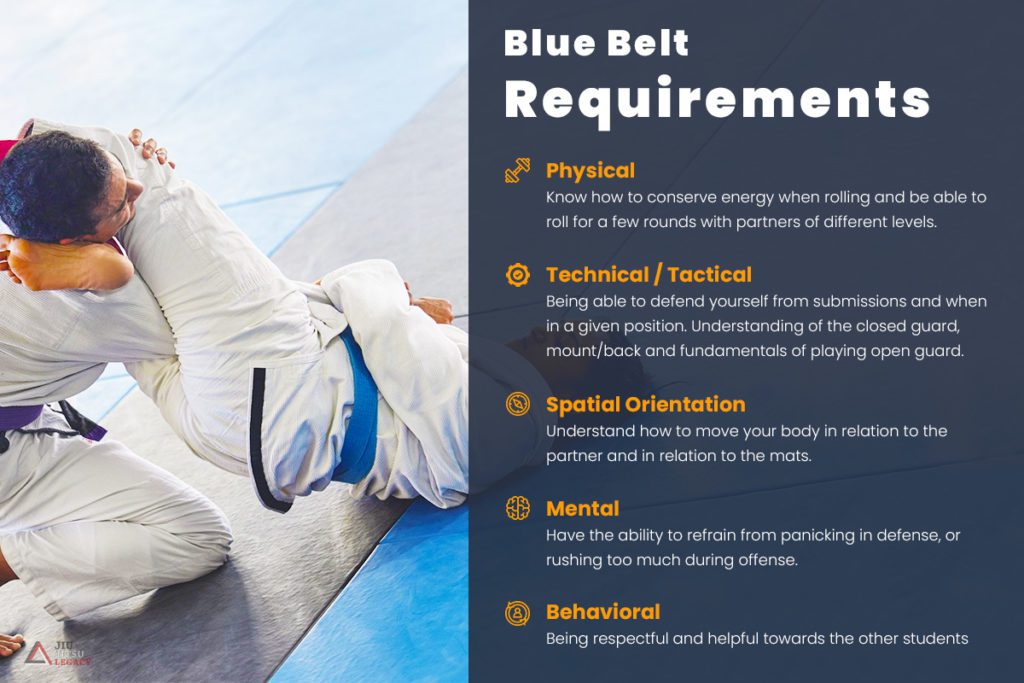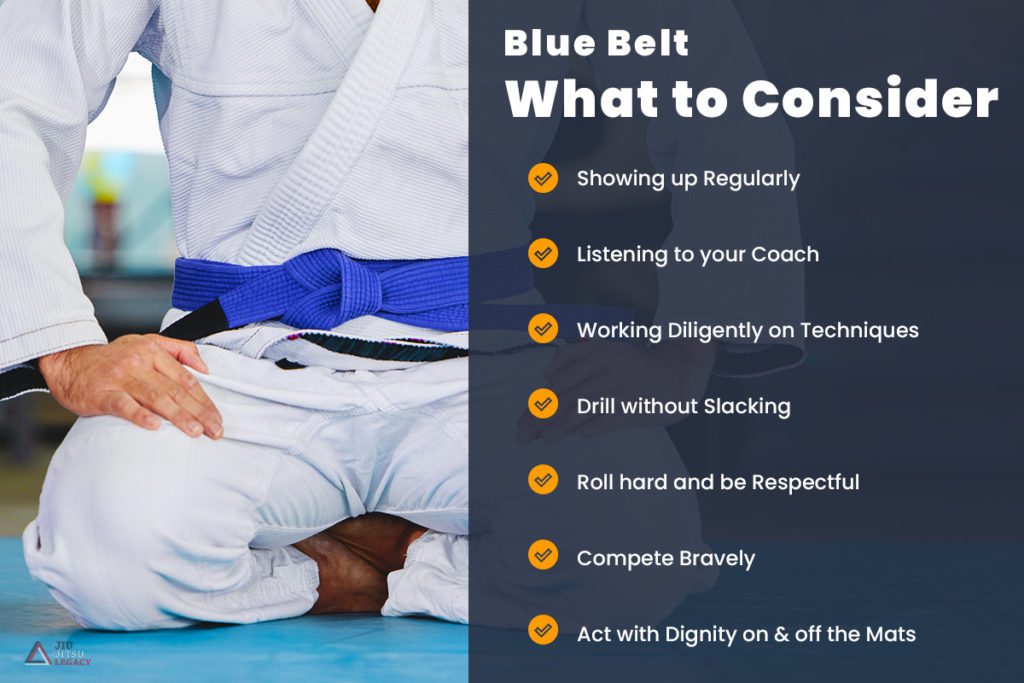For 11 years now, I’ve heard people ask one question more than any other: how long does it take to get a blue belt in BJJ? I get this question more often than them asking technical, tactical, or mindset-related questions. In many ways, the blue belt is the most desired belt in Jiu Jitsu – even more than a black belt – and thus asking such a question is perfectly understandable.
However, you should also really think about the answer when you get it. It just might speed up your journey towards that coveted BJJ blue belt.
The BJJ Belt System
First of all, a couple of words on the origins of the colored belt system in martial arts. If you search the web you will find different and somewhat conflicting esports on how the belt system worked in the early days and how the modern-day multi-color system developed.
I will focus only on Japanese belt origins since Judo and Japanese Jiu Jitsu are in the background of our sport. Until Jigoro Kano, the founder of Judo, started looking into visual ways of distinguishing differently ranked students, there were only certificates, but no belts signifying rank.
There are different stories about what Kano used in the old days of Judo. Being a teacher himself he knew the importance of visually distinctive ranking. It is certain that the white belt was used for beginners and the black for masters.
Some say this stayed the case until after World War two, but there are photos and reports that suggest the brown, and perhaps even purple belts were used in Kano’s original system.
The fact of the matter is that the modern-day multi-colored system is the creation of a Japanese Judoka named Mikinosuke Kawaishi who taught in France in the 1930s. He saw the western need for immediate gratification instead of the valued Japanese tradition of delayed gratification.
In order to teach westerners, he developed a multi-color belt, thus giving a visual representation of the rank to each student.

Nowadays, there are several different colored belt systems used in martial arts. In BJJ the belt system starts with a white belt, followed by a blue, purple, and brown belt, culminating with the black belt. There are other BJJ belts past the black belt, which you can read about in detail in this article.
In terms of awarding belts, we do not typically hold belt exams in Brazilian Jiu Jitsu. Instead promotions only happen when a coach deems their student ready. To that extent, it takes an average of 10 years to get a black belt in BJJ, which means that people spend around two years at every belt level.
What does a Blue Belt in BJJ Mean?
If you take a careful look at the colors used to represent belts in martial arts you will see that the color of the belts gets progressively darker. That, arguably, symbolizes the maturing of the student, as they understand more and more of their respectful art, or in our case, Brazilian Jiu Jitsu.
Apart from this symbolism of knowing more than a complete beginner, the blue belt in BJJ means several other things as well.
First of all, it means that you can handle yourself on the mats. Believe me, a black belt will see a blue and a white belt completely differently when it comes time to roll. A blue belt is someone who has a couple of years of experience in the art, and already knows some of the key aspects of grappling,
Another thing a blue belt represents in Jiu Jitsu is responsibility. I expect nothing but the best behavior from my blue belts given that they are the most realistic example and role model to white belts. While everyone dreams of the black belt, the blue belt is the first rank that seems within reach to beginners, and they often look up to and copy the behavior of blue belts.
Finally, and quite important to me as a coach, is that I expect a blue belt to think for themselves. This doesn’t mean learning BJJ on their own, but I do expect intelligent questions, debates, suggestions, and thoughtfulness about the sport.
In other words, I expect the equivalent of a child going through elementary school – you’re not a baby any longer.
BJJ Blue Belt Requirements in a Nutshell
Taking into account the meaning a blue belt has to me, you can see why it generally takes awhile for me to award someone this grade. Unless I see these qualities in a person, it does not matter to me if they’ve been training for six months or six years. Once they fulfill all the requirements I have, they will get their blue belt.

Physical
Physically speaking, I don’t expect students to lift weights, run, or do any physical activity outside the gym. I also do not consider competition as a must for belt promotions in Jiu Jitsu. However, I do expect them to know how to conserve energy when they roll and be able to roll for a few rounds with partners of different levels.
In general, I expect someone to be able to go through a training session and an open mat without having to stop a 5-minute round halfway in because they are winded. I am willing to make exceptions and accommodations for this as everyone’s state of fitness is unique, but this is my basic guideline.
Technical / Tactical
My approach to Jiu Jitsu is specific to me, and as such it does not involve a set of techniques that people should know. I don’t expect people to know three armbar setups, seven side control escapes, or anything of the sort. That is an ineffective system in my opinion, that everyone should abandon. But that’s a subject for another day.
What I like to see from my blue belts is creativity. Technically speaking, I expect them to primarily be about to defend themselves, both positionally and in terms of submissions.
Next, they should know how to keep someone in the closed guard, mount or back, and finish from there. I also expect them to understand the fundamentals of playing open guard and passing the legs. I call these checkpoints that everyone should have an understanding of regardless of the belt.
What I expect from a blue belt is to be able to string together a few moves, positional, transitional, and/or submissions intentionally, not just opportunistically. Moreover, I expect them to lead their training partner into that trap system, rather than waiting to pounce when an opportunity arises.
Forming connections like this marks the tactical expectations I have out of a BJJ blue belt. Combined with the fundamental understanding of defensive and offensive technical checkpoints, and at least being comfortable going from standing to the ground (takedown or guard pull, doesn’t matter) means you are ready for your blue belt, at least from this perspective.
Spatial Orientation
The answer to the question “How long does it take to get a blue belt in BJJ?” does not only cover technical and physical aspects. For me, having somebody understand how to move their body in relation to their partner and in relation to the mats is also a mark of a blue belt.
Very often we see so many wasted movements from beginners. That is okay, as this is expected out of someone new to the sport. It is also what we mean when we say people “spaz.” I don’t necessarily expect blue belts to have refined movements, but they should have a lot fewer wasteful ones.
Mental
People’s mindset is a very individual and private thing. In that sense, I do not try to influence the way they think, but I do like to guide them towards paths that help with efficient problem-solving. At the end of the day, Joe Rogan’s statement that “BJJ is high-level problem solving under extreme stress” is still one of the best descriptions of the sport for me.
Mentally speaking, a blue belt should have the ability to refrain from panicking in defense, or rushing too much during offense. That is it. No need to visualize themselves as medieval Samurai or read all of Robin Sharma’s self-help books. As a fan of Occam’s Razor, I like to keep things simple.
Behavioral
This is an aspect I place a lot of importance on in my decision to award someone a blue belt. People can fulfill all other requirements but if they can’t “play well with others” they won’t get their blue belt. The way a blue belt behaves is extremely important, as I said before, given their status as role models for the most sensitive category of students – white belts.
I expect a blue belt to treat white belts with respect and help them out. I don’t care how many times they tap them out, it should be done in a way that encourages the white belts to pursue a blue belt themselves, not wreck them and make them question their desire to train.
How Long Does It Take To Get A Blue Belt In BJJ?
After quite a long introduction I will get to the meat and potatoes of this article, answering the one question I set to answer when I started it. I will use several different aspects to make my point and explain my take on the subject.
Expectations
First of all, manage your expectations. Coming into a gym with the goal of reaching the blue belt level in record time is almost certain to backfire on you. When I signed up for BJJ I already had a black belt in Karate, a green belt in Judo, and 20 years of competitive martial arts. It took me two and half years to reach blue belt.
Your background, athletic abilities, or desires have nothing to do with how long it will take you to earn a blue belt in BJJ. It will have to do everything with the requirements your coach has set for a blue belt, which, by the way, might differ significantly from mine.
Reality
I would say that it is very difficult to earn a blue belt faster than a year.
The most important thing to remember is that even if you are a mat rat (being on the mats for hours on end every day) as a white belt, you may still need a year or two in order to reach the blue belt.
The reality of BJJ is that you can’t learn movies or techniques in a single training session. It takes time for things to “click” together, and it takes everyone a different amount of time for those clicks to take place.
Until they do, though, enjoy your time as a white belt instead of focusing solely on your blue belt promotion.
Key Factors To Consider

Showing up to training regularly, listening to your coach, working diligently on techniques, drilling without slacking, rolling hard but at the same time respecting every training partner, competing bravely, and acting with dignity on and off the mats. These are all key factors that determine how long it takes to get a blue belt in BJJ.
Sometimes people might remain longer at white belt. They might come in with habits from other martial arts that are actually detrimental rather than helpful to their progress in BJJ.
On the other end of the spectrum are people that might not fulfill every blue belt requirement on the list, but they desperately need a win in their life. If I can offer that in the form of a blue belt, and set in motion a series of events that improve someone’s overall life, it doesn’t matter if they got the promotion a few months early.
My point is that situational and personal factors play an important role in promoting someone to a blue belt. Believe me, coaches take this very seriously and sometimes spend weeks thinking their decisions over before acting on them.
How Can We Improve The Timeline?
As a BJJ coach, I would love to improve the timeline it takes to get from one belt to another. In fact, I would very much love to shorten the expected 10 years from white to back to around 8, for starters. Of course, this doesn’t mean handing out belts left and right in order to prove a point. It makes no sense.
However I do advocate improving training methods, most importantly the way we teach, so that we focus on teaching people more in less time, rather than boasting about how long it takes to earn a belt in BJJ. It should be about the knowledge and our students – and as coaches if we can prepare our students efficiently and thus more quickly, we should.
My Thoughts About BJJ Belt Stripes
The BJJ stripe system ties straight into the human need for immediate and visually recognizable gratification. I understand how important stripes are to people, I’ve had my fair share of them in my BJJ journey. That said, do not take stripes too seriously, because we as coaches surely do not.
The stripes are there to make you satisfied with the tiny steps of progress you’re making. In the grand scheme of things, even belts only represent small leaps in progress. Only after you get the black belt will you get the freedom to start learning Jiu Jitsu in a way that is unique to yourself.
So, when it comes to stripes, forget about asking for more of them or comparing yourself to others who might have gotten more or fewer stripes than you in a promotion. It is not something that you should take seriously at all.
Summary
I expect that I will be making changes to this article in a couple of years’ time. As I learn more and as the entire BJJ community evolves so will the requirements for getting a blue belt.
Hopefully the answer to the question” how long does it take to get a blue belt in BJJ” will be shorter than the one I gave now. The one thing I know won’t change is the fact that everyone desires to get that blue belt more than they do the black because nobody wants to be a beginner at anything.
Icons created by Freepik – Flaticon

Ogi is a black belt that does Jiu Jitsu full time and is very passionate about anything grappling-related.
He is also the head coach of Enso Jiu Jitsu in Macedonia and an aspiring Globetrotter.
